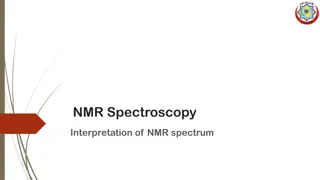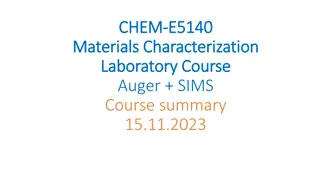Understanding Basic Concepts of Hyperspectral Imaging and Spectroscopy
Exploring the fundamental principles of hyperspectral imaging and spectroscopy, this content covers topics such as interference, diffraction, spectrometer workings using diffraction gratings, and wave properties. Lectures by Adjunct Professor Fred Sigernes delve into topics like basic spectroscopy, system optics, and calibration imaging spectroscopy. The course emphasizes understanding key optical elements like diffraction gratings and their applications in remote sensing.
Download Presentation

Please find below an Image/Link to download the presentation.
The content on the website is provided AS IS for your information and personal use only. It may not be sold, licensed, or shared on other websites without obtaining consent from the author. Download presentation by click this link. If you encounter any issues during the download, it is possible that the publisher has removed the file from their server.
E N D
Presentation Transcript
BASIC HYPER SPECTRAL IMAGING Fred Sigernes 1,2,3,4 1The University Centre in Svalbard (UNIS), N-9171 Longyearbyen, Norway 2 The Birkeland Centre for Space Science (BCSS) 3 The Kjell Henriksen Observatory (KHO) 4Centre for Autonomous Marine Operations and Systems (AMOS) NTNU Lectures: TTK20 Hyperspectral remote sensing, Module 1, AMOS NTNU, 11-13 September, 2018.
Lecture plan: TTK20 Hyperspectral remote sensing Module 1 Instructor: Adjunct Professor Fred Sigernes Day 1 09:15 11:00 13:15 15:00 Basic Spectroscopy Spectral Designs Day 2 09:15 11:000 13:15 15:00 System Optics Throughput and Etendue Day 3 09:15 11:000 13:15 15:00 Calibration Imaging spectroscopy Lectures: TTK20 Hyperspectral remote sensing, Module 1, AMOS NTNU, 11-13 September, 2018.
Introduction In order to explain how a spectrometer works, it is necessary to refresh some basic concepts of physics like interference and diffraction. The key optical element of a spectrometer is the diffraction grating. In this chapter we will derive properties such the grating equation, angular dispersion, and grating efficiency.
DAY 1: BASIC SPECTROSCOPY 1.1 Light as waves 1.2 Interference 1.3 Diffraction 1.4 The GRISM 1.1 Light as waves Sinusoid wave = ( , ) sin( ) E x t E kx t Amplitude 0 T= v Period (s) k=2 / Wave number =2 / . Angular frequency
A wave by complex mathematics = + z x iy = + (cos sin ). z E i 0 Euler s formula = + ei cos sin i kx = t Real part of is = = Re cos z E E 0 In 3D a wave is expressed as ie t = r E r E ( = , k ) t 0 + is the initial phase of the wave
DAY 1: BASIC SPECTROSCOPY 1.1 Light as waves 1.2 Interference 1.3 Diffraction 1.4 The GRISM = + E E E 1 2 1.2 Interference Two wave sources Amplitudes i = E E e Intensity 1 1 01 i i i i i = = + + * E E E E E E E E e ( ) ( ) I e e e e 2 1 2 1 2 2 02 01 02 + 01 02 e 2 2 ( ( = + + ) ) i i E E E E ( ) e 1 2 1 2 Phases 01 02 01 E 02 E 2 2 = + + E E 2 cos( ) = + t + k r t 01 02 01 02 1 2 1 1 1 r 1 2 2 = + + E E E E 2 cos = k 01 02 01 02 2 2 2 2 = + k r k r ( ) ( ) Phase difference 1 1 2 2 1 2 ) 1 2 n n Constructive interference Destructive interference = + 2 (
Several wave sources Amplitudes k r = ( ) i t E E e 1 1 01 k r = ( ) i t E E e 2 2 01 k r = ( ) i t E E e 3 3 01 k r = ( ) i t E E e N 01 N Phase difference between waves sin a = 2 Distance P much larger than a then we can use the rotating vector sum to get the total E at P. = = 2 E CP QP 1 = 2 sin( ). N 2 Triangle QCR gives 1 = 2 sin( ) E 01 2
Eliminating The intensity is proportional to E2 2 1 1 sin( ) N sin( ) N 2 a sin( sin / ) N a 2 2 E = = = E I I I 1 01 1 0 0 sin( sin / ) sin( ) sin( ) 2 2 Example N = 10 n = = n sin a 2 Maxima N2I0 Zero intensity / 1 ( = ) 2 N n N-2 minima between peaks Half widths of peaks = 2 / N
DAY 1: BASIC SPECTROSCOPY 1.1 Light as waves 1.2 Interference 1.3 Diffraction 1.4 The GRISM 1.3 Diffraction Diffraction may be seen as the interference of a finite wave itself. Example of diffraction: Ocean waves hitting a port entrance wall. Huygens principle state that every point of a wave front can be thought of as the source of secondary wavelets. These new waves are defined as the diffracted waves, each with amplitude dE01. The phase difference between CC and AA 2 2 sin x The single slit. = CD =
The rotating vector sum 1 = QP = 2 2 sin( ). E 2 2 sin b = = ( ) E When = 0 0 b / sin( sin / ) b = E E 0 sin 2 2 sin( sin / ) sin b u = = u = I I I sin / b 0 0 sin / b u Example u = n Minima I0 = n sin b Maximum ( ) 2= sin / 1 u u u = 0 Red wavelengths are more diffracted than blue
The diffraction grating The net intensity is simply interference caused by N slits, modulated by the diffraction pattern of one single slit 2 2 a b sin( sin / ) sin( sin / ) N a b = I I 0 sin( sin / ) sin / Example Note that for each wavelength we obtain maxima at different angles except for zero order. This is the same for all wavelengths. Or in other words, we obtain spectra on each side of zero order. Also note that the location of the intensity maxima for each order increases for increasing wavelength.
The reflective grating The plane reflective gratingmay be thought of as a polished surface that has parallel grooves which have been made by a sharp diamond. The grating consists of narrow parallel mirrors, where each mirror acts a source of interference in the same manner as described before. The phase difference between each source due to path difference 2 = + ( ) BC AD 2 = + ( sin sin ) a a = 2 n Maxima occurs at The grating equation n = a + (sin sin ) = Littrow condition
The blazed grating Note that so far most of the intensity is diffracted into the zero order. If the reflective surfaces are tilted at an angle bto the grating normal k, we have a blazed grating. bis known as the blaze angle. 2 2 2 ) = + = + = + ( ) ( sin sin ) cos sin( ) sin( BC AD d d a b b b Also, note that the phase difference between the rays S1and S2, as a result of the grooves, is the same as before. This means that the interference pattern is not shifted in angle, and that the grating equation still holds.
Example blazed grating Most efficient when = b b Each surface will act as a small mirror, reflecting the rays with equal angles from the groove normal. The blaze wavelength = + (sin sin ) n a 1 1 = + 2 sin ( ) cos ( ) n a 2 2 = + = 2 b b b = = ( 2 ) ( 2 ) b b 2 a = sin cos( ) b b b n
Overlapping spectral orders The grating equation n = a + (sin sin ) The overlapping wavelengths are a multiple of the factor (1/n) from the grating equation Air at ground level absorbs light below ~190 nm. If you, for example, need to make a first order measurement in the visible spectral range 400 to 600 nm, then you will need to block out second order overlapping wavelengths from 200 to 300 nm. Resolving power = R n N It is a theoretical measure of a grating s ability to separate adjacent spectral lines. For example, a resolving power of R=(600 grooves/mm)x12mm = 7200, will result in =0.07nm at =500nm for n=1.
n = R R n n a sin = = N N Resolving power? Previously (several sources interference) 2 The closest phase change from zero to maximum intensity: = sin a n = sin a 2 2 = = d n d N Differentiating: 2 Rearranging: d = d cos a = R n N d = d cos a n
Angular dispersion Differentiating the grating equation gives the angular dispersion a d It is a measure on how rays spread out in a diffracted angle per unit wavelength, and it plays a key role in the calculation of the instrumental bandpass. Note that the angular dispersion increases with order. d n = cos Grating efficiency + I n d ( ) = n 100 E n + / 2 I d ( ) / 2 cos = Na n Theoretical efficiency for a grating with 600 grooves / mm and a blaze angle b = = 9.63o. The blaze wavelength b= 557.7 nm for n = 1.
DAY 1: BASIC SPECTROSCOPY 1.1 Light as waves 1.2 Interference 1.3 Diffraction 1.4 The GRISM 1.4 The GRISM A prism stacked in series with a transmission grating forms a diffractive element known as the GRISM or the Carpenters prism. Key equations = sin sin B p n Snell s law Straight through wavelength = + = = 1 np A . Cauchy s formula 1 2 The modified grating equation n = + = + (sin sin ) ( sin sin ) a a p n Note that a prism disperses blue light more than red, whereas the grating diffracts red light more than blue.
Example GRISM Computer generated ray tracking for GRISM. P is wedged prism with = 30o. G is 600 lines/mm grating. First order spectral range: 400 700 nm The prism material is Barium Crown (BaK4). Note that the yellow - green wavelength close to ~500 nm passes straight through the GRISM, parallel to the x-axis. This on-axis effect of the GRISM is favorable due to the simplicity to stack additional optics on both the front and back side of it. Image quality will be preserved due to negligible off-axis effects. The GRISM has increased angular dispersion compared to using a grating alone
THE GRISM Angular dispersion? n = + = + (sin sin ) ( sin sin ) a a p n B = + 1 np A 1 2 dn d d B p = + = + sin cos 2 sin cos n a a a a 1 d d d 3 d + 3 2 sin / n aB = 1 d cos a 3 2 sin / 0 aB 1























